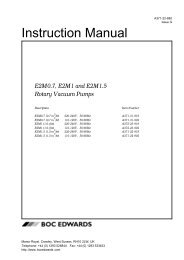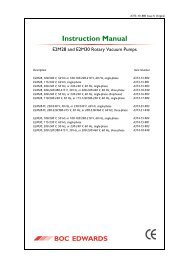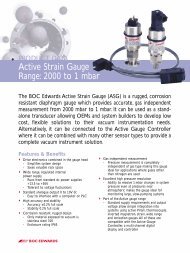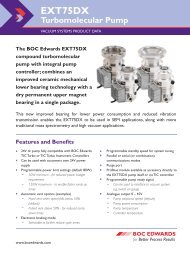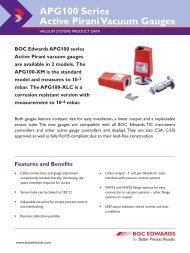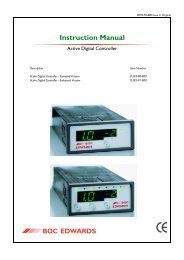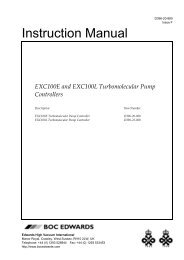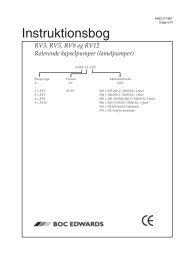EXT556H turbo pump user manual
EXT556H turbo pump user manual
EXT556H turbo pump user manual
You also want an ePaper? Increase the reach of your titles
YUMPU automatically turns print PDFs into web optimized ePapers that Google loves.
<strong>EXT556H</strong><br />
PAGE<br />
26<br />
MAINTENANCE<br />
Symptom Check Action<br />
The EXT is very noisy or there is<br />
excessive vibration or both.<br />
Are any of the vacuum gauges<br />
contaminated<br />
Is the <strong>pump</strong>ing speed insufficient<br />
(due to poor conductance<br />
between the <strong>pump</strong> and the gauge<br />
or too large a chamber)<br />
Is the backing pressure > values<br />
given in Table 7<br />
Is the high-vacuum area of the<br />
system contaminated<br />
Check the rest of your system for<br />
leaks and contamination.<br />
Remove the <strong>pump</strong> from the<br />
system and test the ultimate<br />
pressure of the <strong>pump</strong> alone (see<br />
Section 3 for specification).<br />
Is the <strong>pump</strong> rotational speed the<br />
same as the resonant frequency of<br />
the attached system<br />
Is the vibration being transmitted<br />
from the rotary <strong>pump</strong><br />
Is the noise irregular and getting<br />
progressively worse<br />
Is the EXT making a constant highpitched<br />
noise<br />
If so, clean or replace them.<br />
Increase the conductance or<br />
reduce the volume.<br />
Check for backing line leaks. If the<br />
backing pressure is too high, you<br />
may need a larger backing-<strong>pump</strong>.<br />
If so, clean the high-vacuum<br />
system.<br />
If found, clean the contaminated<br />
areas and repair the leaks.<br />
If poor, check the <strong>pump</strong> for<br />
contamination and if necessary<br />
clean as described in<br />
Section CAUTION. Leak-check<br />
the <strong>pump</strong>. If the leak rate > 10 -8<br />
mbar l s -1<br />
(10 -6 Pa l s -1 ) consult BOC<br />
Edwards or your supplier.<br />
If so, change the natural frequency<br />
of your system or isolate the <strong>pump</strong><br />
using flexible bellows.<br />
If so, fit flexible bellows or a<br />
vibration isolator in the backing<br />
line.<br />
If so, a bearing is defective. Switch<br />
off the <strong>pump</strong> and consult BOC<br />
Edwards or your supplier.<br />
If so, the rotor might be out of<br />
balance. Consult BOC Edwards or<br />
your supplier.<br />
None of the above. - Consult BOC Edwards or your<br />
supplier.<br />
Table 8 - Fault finding (continued)<br />
Issue A 26<br />
Aug 05



